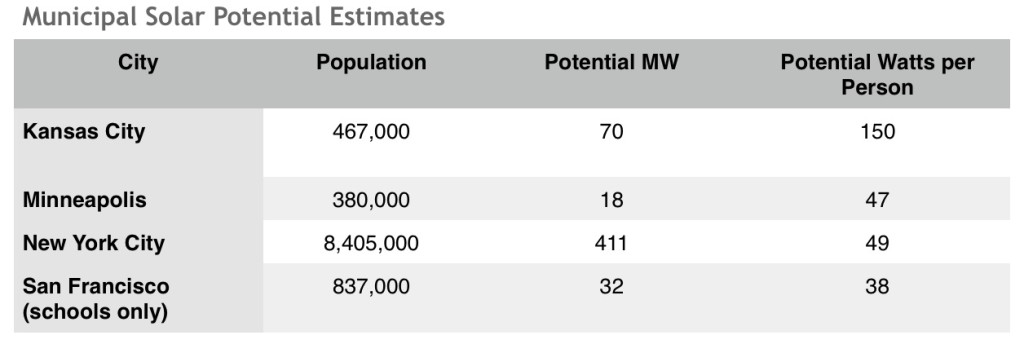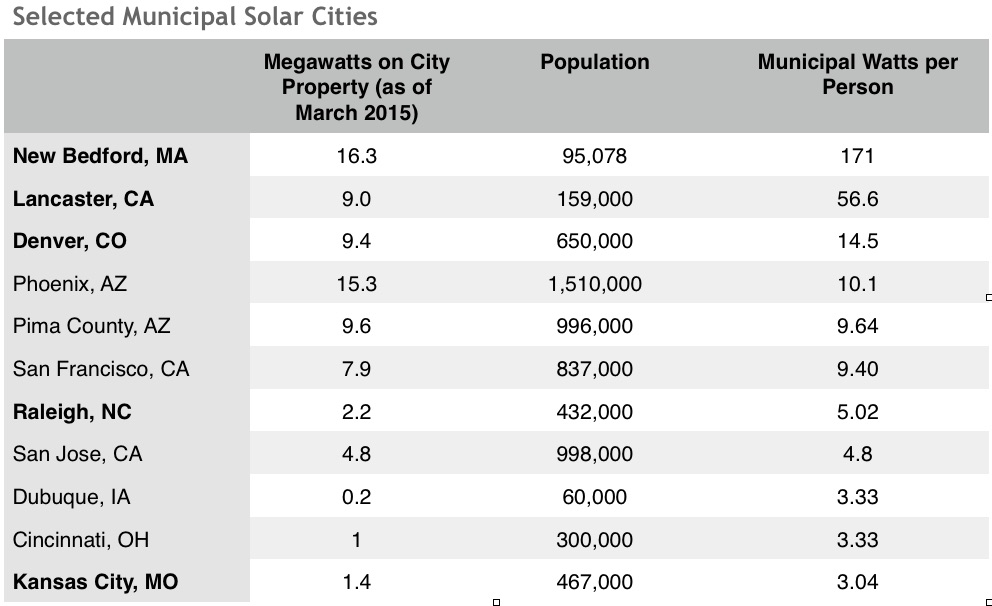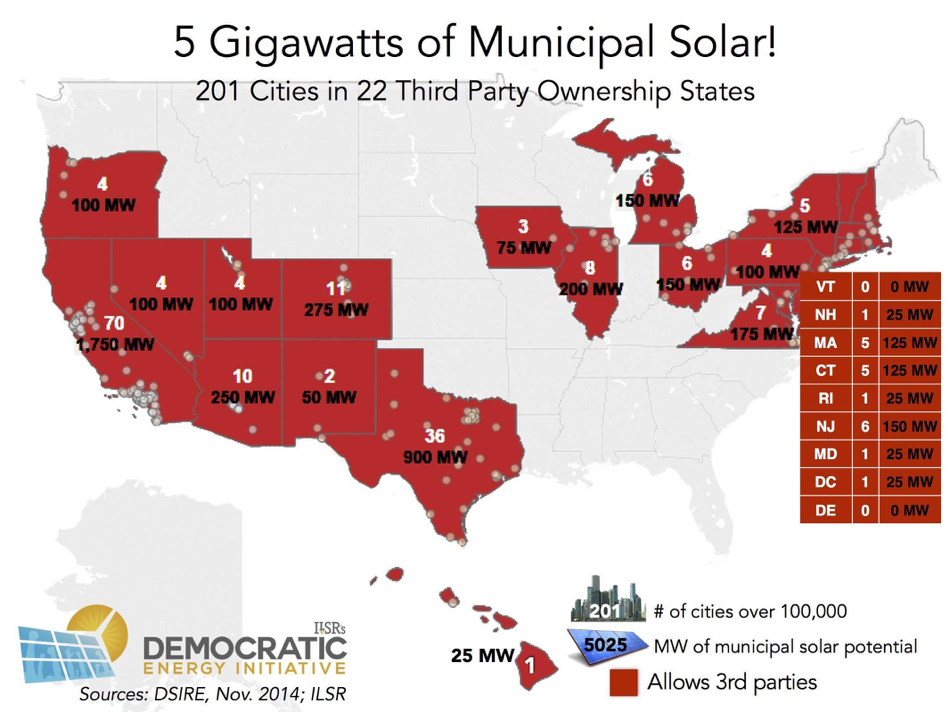There are a lot of stories on residential rooftop solar but few if any on what cities are doing to make themselves energy self-reliant by using their own buildings and lands to generate power.
In Public Rooftop Revolution, ILSR estimates that mid-sized cities could install as much as 5,000 megawatts of solar—as much as one-quarter of all solar installed in the U.S. to date—on municipal property, with little to no upfront cash. It would allow cities to redirect millions in saved energy costs to other public purposes.
This report is being released in serial format, beginning Monday, June 1 through Thursday, June 4. CHECK BACK TOMORROW FOR UPDATES.
Read the Executive Summary
Read Part 1 of the report
Read Part 2 of the report
Listen to our podcast conversations with a few of our Featured Five municipal solar cities:
Lancaster, CA city manager Jason Caudle, listen to the podcast, read the interview summary.
Raleigh, NC renewable energy coordinator Robert Hinson, listen to the podcast, read the interview summary.
Kansas City, MO project manager Charles Harris, listen to the podcast, read the interview summary.
The Third Party Trump Card
Although cities face a number of challenges, economic and otherwise, to installing solar, the third party ownership option—if available—ought to trump most of them. For suitable sites that won’t need a near-term roof replacement, third party ownership removes virtually all of the financial barriers to solar, and covers maintenance and operations. While some barriers (like lack of aggregate or virtual net metering) remain, most cities have a substantial solar opportunity.
ILSR estimates that over 5,000 MW of solar could be inexpensively installed almost immediately on municipal property in states with laws allowing third party ownership. This amount is more than a quarter of the nationwide total solar capacity through September 2014, and it only includes the municipal buildings of the approximately 200 cities with 100,000 or greater population.
We arrive at this number by estimating the solar potential for cities in states where third party ownership is allowed, based on the following four estimates of rooftop solar potential ILSR obtained. The estimates are shown in the table below.
Although there’s an impressive range of potential from this small sample, ILSR estimates that each city can, on average, install 25 MW of municipal solar. For comparison, the city with the most municipal solar Watts per capita, New Bedford, MA, has 16 MW, but is also smaller than 100,000.
The result is an impressive array of municipal solar potential in 23 states (plus DC) with third party ownership and 201 cities larger than 100,000. Cumulatively, these cities could have third parties install over 5,000 MW of solar on municipal buildings, as shown in the map below. Note that two states allowing third party ownership have no cities larger than 100,000 population, Vermont and Delaware.
Though the map says it powerfully, it’s worth repeating that there’s an enormous solar opportunity waiting for cities to seize it.
As a word of warning, this estimate may not account for the wide variation in solar net metering laws. While solar-leader New Bedford can obtain over a third of its solar for municipal use off-site (using virtual net metering) and apply solar production on any city property to any of its utility bills (aggregate net metering), cities in other states will find net metering policies less favorable. They may be constrained to using just what space is available and suitable on their own property, and perhaps not even be able to aggregate their energy use across properties to find the must suitable solar site for serving municipal-wide needs.
The Featured Five Solar Cities
The following five cities were selected to provide a diverse view of municipal solar leaders. Some, like California’s Lancaster, have a particularly good solar resource and high electricity prices that have enabled them to quickly maximize solar installations. New Bedford has benefited from high electricity prices and terrific state policy. Kansas City and Raleigh illustrate how cities can succeed even against challenging odds. Denver has used substantial open land at its distant airport to significantly expand its solar capacity.
These solar leaders don’t always have the most solar per capita, but their story can help other municipalities navigate how to add more solar on public buildings.
The following table features the installed solar capacity on municipal property for cities for which ILSR was able to obtain data. There are likely some cities that have more Watts per person on municipal property that we could not identify prior to publication.
Bold denotes featured in this report
In the introduction to each city, we share some basic comparable statistics. Of particular interest is the cost of (unsubsidized) solar. In two cities of our Featured Five, Lancaster and New Bedford, solar is cheaper than grid electricity, helping drive substantial development.
Lancaster, CA
 Located just north of Los Angeles in the arid Antelope Valley, the city of Lancaster is quickly becoming the solar capital of the United States. Led by a visionary mayor, the city is aiming for net zero carbon emissions from electricity consumption. The goal is to produce more electricity from solar “on a daily basis” than the entire city consumes (requiring 530 MW of solar capacity installed). The bold goal has led to significant solar installations on public and private property.
Located just north of Los Angeles in the arid Antelope Valley, the city of Lancaster is quickly becoming the solar capital of the United States. Led by a visionary mayor, the city is aiming for net zero carbon emissions from electricity consumption. The goal is to produce more electricity from solar “on a daily basis” than the entire city consumes (requiring 530 MW of solar capacity installed). The bold goal has led to significant solar installations on public and private property.
The city has contracted substantial solar capacity for its own use—9 MW—sufficient to produce all of the electricity consumed by schools and 90 percent of the usage of five municipal buildings, at an annual average price––13 cents per kilowatt-hour––lower than that offered by the incumbent electric utility. The savings to the city are approximately $450,000 per year.
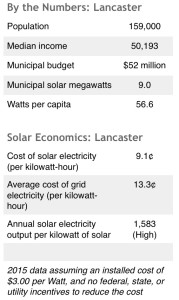 The effort to install municipal solar has also helped the city near its Phase 1 benchmark toward net zero. With 118 MW installed by May 2015 (9 MW on public property), the city is over halfway to producing enough energy with solar to meet the city’s peak energy demand of 215 MW. With projects in the pipeline, the city expects to reach this goal by the end of 2015.
The effort to install municipal solar has also helped the city near its Phase 1 benchmark toward net zero. With 118 MW installed by May 2015 (9 MW on public property), the city is over halfway to producing enough energy with solar to meet the city’s peak energy demand of 215 MW. With projects in the pipeline, the city expects to reach this goal by the end of 2015.
The solar push began in 2010 with power purchase agreements for solar installations on city hall, a performing arts center, and the municipal stadium (host of the JetHawks minor league baseball team). Together, with two other cities properties, the five sites generate 1.5 MW from solar and save the city $50,000 per year in electricity costs. The power purchase arrangement means that SolarCity owns the solar arrays on the public facilities, but it sells the electricity to the city at a discount to grid electricity prices. This allows SolarCity to capture federal tax incentives for building solar arrays and the city to benefit as well.
It was the next phase of Lancaster’s solar expansion highlighted the city’s willingness to innovate. The city rejected a power purchase agreement offered by SolarCity for city schools, saying it was “unaffordable.” Instead, the city formed a public power agency to purchase the panels outright and sell the power to the city’s schools.
[Financed by low-cost municipal bonds], it bought 32,094 panels, had them installed on 25 schools, generated 7.5 megawatts of power and sold the enterprise to the school district for 35 percent less than it was paying for electricity at the time.
The school investment model is one that the city hopes other cities can emulate, in part because the arrangement still allows for capture of the federal tax incentives. The power agency bought the solar arrays from SolarCity, but the contract leaves the company responsible for maintenance and a guaranteed minimum level of electricity output. The agency, dubbed the California Clean Energy Authority, sells the power to the school district on a long-term contract. In addition to selling power to the schools, the Energy Authority also earns revenue from leasing land under its control to third party solar developers, similar to what Raleigh, NC, is doing.
Though it has yet to be tapped, Lancaster’s Clean Energy Authority offers the same opportunity to any California municipality interested in leveraging its low cost of capital without becoming a municipal electric company. The city doesn’t have to own poles or wires, or operate the electric grid, but it can finance solar panels and other renewable energy equipment at very low cost.
Lancaster’s solar success results from its ingenuity and a number of other key factors. The mayor, city council, and city manager have all been big advocates of the solar efforts. Lancaster’s solar resource is about 30% better than the U.S. average, meaning it gets 30% more electricity than an identical solar array installed in, for example, Missouri. State policies have also been very helpful:
California does not require the city to competitively bid the solar power purchase contracts.
The California Solar Initiative has provided performance-based incentives for solar electricity production for several years, though they have now expired.
State policies have dramatically simplified interconnection of solar and allow third party solar purchasing arrangements.
Beyond Municipal
Lancaster’s net zero goal means the city is pushing for local clean energy beyond municipal operations. In 2010, the city co-marketed a “Solar Lancaster” partnership with SolarCity—with financing and discount purchasing program—to get solar installed on 130 homes. At the same time, the city streamlined rules for solar on private property, earning a “Good” score on its permitting practices from Vote Solar. It has also partnered with home developer KB Homes to construct net-zero energy homes in Lancaster, dramatically lowering both electricity and water consumption.
In 2013, the city adopted a solar mandate, requiring all new housing developments to have an average of 1 kilowatt of solar per home.
In 2015, Lancaster is launching a community choice aggregation program. The aggregation program gives the city the power to choose the energy supply on behalf of its residents and small businesses. The implementation plan calls for 185 MW of local utility-scale renewable resources and 33 MW of distributed solar within city boundaries and additional resources from the larger grid. Any potential supply could include contracting with large-scale wind or solar producers, or standard contracts to buy solar power from Lancaster residents and businesses.
All told, Lancaster is a model for both public and private sector solar installations. Its municipal solar capacity puts it among the top cities in the country in public solar per capita. The push beyond municipal solar has also been successful. The city has enough solar in the pipeline to match the city’s peak daily energy demand of 215 MW by the end of 2015. With its local aggregation able to make decisions about the energy supply, the city is well on its way to its net zero goal of 530 MW of solar.
New Bedford, MA
Wha le oil made New Bedford an energy capital of America in the 19th century. Today this coastal Massachusetts town continues to lead with solar energy for municipal use, not because of abundant sun or wealth—New Bedford family median income is nearly one-third lower than for the U.S. as a whole— but due to good policy.
le oil made New Bedford an energy capital of America in the 19th century. Today this coastal Massachusetts town continues to lead with solar energy for municipal use, not because of abundant sun or wealth—New Bedford family median income is nearly one-third lower than for the U.S. as a whole— but due to good policy.
The city jumped into solar on the heels of the 2008 Massachusetts Green Communities Act, which was designed to accelerate the development of energy efficiency and solar energy. This Act provided several key tools:
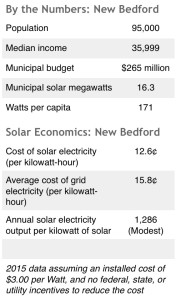 Boosted the maximum size of net metered projects, improved compensation for excess generation, and allowed more net metered solar to be installed; also, set a statewide 250 MW solar target, since surpassed.
Boosted the maximum size of net metered projects, improved compensation for excess generation, and allowed more net metered solar to be installed; also, set a statewide 250 MW solar target, since surpassed.
Provided technical assistance for procuring renewable energy for towns that adopt specific energy conservation measures, tougher building energy codes, and policies encouraging private sector development of renewable energy.
Created a market for solar renewable energy credits (SRECs) that accrue to all grid-connected solar projects for every megawatt-hour of energy produced. High prices for these credits—50-57¢ per kilowatt-hour in early years, and averaging 25-27¢ per kWh since 2012—help speed payback of solar investments.
New Bedford’s energy office opened in 2010, with the goal of having 10 MW of solar installed by 2015, to meet 25% of municipal energy needs. By late 2014, the city had far surpassed its goal, with 16.25 MW of installed solar capacity, sufficient to meet 52% of the city’s municipal electricity needs.
All of the city’s solar capacity is financed with a power purchase agreement with SunEdison. With its tax equity investors capturing federal and state tax incentives, SunEdison sells the solar electricity to the city for 12 to 16 cents per kilowatt-hour—far below market rates. The city gets just under half the solar energy from installations on eight city properties, and the remaining half from two off-site, though nearby, solar arrays. The savings on the city’s $6 to $7 million electric bill amounts to 2.5% of its entire budget!
Scott Durkee, director of the city’s Energy Office, cites several innovative policies for the city’s success with solar. The state’s 2008 Green Communities Act was key, offering technical and especially financial assistance to communities that made a number of commitments to facilitate conservation, efficiency, and clean energy. Multiple incentives pushed costs down, including the 30% federal tax credit (taken by SunEdison), the double depreciation allowed through the federal stimulus law in 2009, and the SRECs that have been sold to other utilities.
Three other policies played a key role:
The availability of the power purchase option for the city to buy power from a non-utility supplier (legal in 24 states);
Aggregate net metering (legal in 17 states), which allows the city to apply power production at one municipal site, e.g. the water treatment plant, against all the city’s meters;
Virtual net metering (legal in 11 states), which allows solar energy produced anywhere in the utility’s service territory to be applied against the utility bill of the city. Half the city’s solar electricity comes via this kind of off-site installation.
The city has nearly reached its limit on solar potential. State net metering limits cap additional production from the already selected sites, and structural and shading issues prevent the use of additional buildings.
Solar is the start, but it is a spark toward greener and more efficient energy use for the city.
The mayor sees the solar panels as the first step in a broader plan. His goal is to eventually obtain all of the city’s electricity from renewable sources. He would also like to replace New Bedford’s municipal lighting with more-efficient LED bulbs, convert oil-fired boilers to run on natural gas, and refit city buildings with insulation and new windows.
Street lighting, greener fueling, and energy efficiency management tools are already projected to reduce the city’s electric use by 20%. The cost of financing the street lighting project (completed in 2014), is more than offset by the $550,000 in annual savings in electricity and maintenance costs.
Like Lancaster, the city is also trying to extend energy savings and solar to its residents and small businesses. The Energy NOW program, launched in 2012, combines energy efficiency, solar, and a conservation challenge. It offers a no-cost energy assessment, financing, and promises to use local labor for weatherization or solar installations. The city also has discounted pricing on solar panels purchased through the program.
New Bedford’s Energy Office director has this advice for other cities:
Don’t be too conservative. Go big, and perhaps go solar. “It is critical that you understand your capacity,” he says, “and that capacity will then drive how aggressively” you plan your energy-buying strategy, aiming to reap economies of scale. New Bedford discovered it has a “wonderful capacity” for solar. Other cities may not have it, or may elect to rig just a few buildings, “but anything they do is better than standing with the status quo.”
Denver, CO
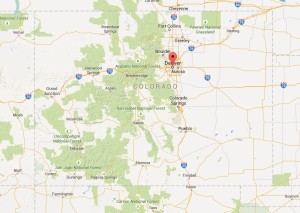 The mile-high city of Denver is just a bit closer to the sun than most American cities and it has accordingly taken action. The city has nearly 14 MW of solar installed on public buildings, including 10 MW at its international airport. The municipal solar represents a quarter of all solar installed in the city, a total capacity that puts Denver among the top 15 of U.S cities.
The mile-high city of Denver is just a bit closer to the sun than most American cities and it has accordingly taken action. The city has nearly 14 MW of solar installed on public buildings, including 10 MW at its international airport. The municipal solar represents a quarter of all solar installed in the city, a total capacity that puts Denver among the top 15 of U.S cities.
When the city first installed solar on its buildings, it purchased the panels outright to maximize its return on investment. Over time, though, the city shifted to using power purchase agreements to reduce its upfront and maintenance costs. These agreements are now the dominant financial structure for municipal solar in Denver.
Denver is known as much for employing innovative strategies to fund its solar installations as it is for its substantial solar capacity. For example, while the four-part airport solar project got its start in 2008 with generous utility and federal tax incentives, the final segment employed a unique twist on the power purchase contract.
 All four segments are owned by third parties, with the city purchasing the electricity on long-term contracts at a savings over grid electricity. But in the final phase, the solar company building the solar array borrowed $4 million of the $7 million project cost from the airport itself, with the loan secured by the panels and the project’s renewable energy credits. Since the federal tax credit and accelerated depreciation returns nearly 50% of the project’s cost to the developer within the first 5 years, the default risk is minimal.
All four segments are owned by third parties, with the city purchasing the electricity on long-term contracts at a savings over grid electricity. But in the final phase, the solar company building the solar array borrowed $4 million of the $7 million project cost from the airport itself, with the loan secured by the panels and the project’s renewable energy credits. Since the federal tax credit and accelerated depreciation returns nearly 50% of the project’s cost to the developer within the first 5 years, the default risk is minimal.
Another of Denver’s touted solar projects is a partnership between the city and the county Housing Authority. A power purchase agreement with Enfinity America Corporation allowed the installation of 2.5 MW of solar on more than 350 Authority affordable housing properties, averaging 6.5 kilowatts (kW) per property. The agreement was essential, because the Authority lacked the capital to install the solar outright and allowed the government program to take advantage of the federal New Markets Tax Credit, which provides a discount of 39% on “investments into operating businesses and real estate projects located in low-income communities” over seven years.
The Housing Authority benefits from the solar installations in two ways: It pays less for electricity as a result of the agreement, and it receives revenue from leasing the roofs to the solar company. Altogether, the project generates “3.4 million kilowatt-hours of electricity per year, which is an annual reduction of around 3,400 tons of carbon dioxide”
Denver has largely stopped expanding its solar investments for two reasons. First, many of the publicly-held properties have neither sufficient roof strength to hold the additional weight of solar panels nor a south-facing, sunny rooftop. Second, the city is interested in waiting to see whether predicted price reductions and technology improvements will make future solar investments even more cost-effective.
Despite slowing its own solar investment, the city has taken steps to make solar on private property more affordable. Supplementing strong state policies on net metering and low-cost grid connections, the city has reduced solar permitting fees to a flat $50 and introduced same-day permit review. Solar projects are also getting priority scheduling for city review.
Denver has become a municipal solar leader in part because the airport’s energy use and open land enable simple and substantial solar installations without having to use virtual net metering. For now, that may be the limit to Denver’s municipal solar installations.
Kansas City, MO
 Kansas City, MO, has neither the abundant sunshine nor high cost of electricity that have driven solar installations in other cities. Despite this, the city has close to 1.5 MW of solar in 59 separate installations on municipal properties. Due to utility rebates, two department leaders, and a unique opportunity that allowed it to access the 30% federal tax credit, the city was able to make solar work in an otherwise challenging climate of modest sun and low electricity prices.
Kansas City, MO, has neither the abundant sunshine nor high cost of electricity that have driven solar installations in other cities. Despite this, the city has close to 1.5 MW of solar in 59 separate installations on municipal properties. Due to utility rebates, two department leaders, and a unique opportunity that allowed it to access the 30% federal tax credit, the city was able to make solar work in an otherwise challenging climate of modest sun and low electricity prices.
Like many other cities, Kansas City was able to lease its solar arrays in order to avoid the upfront costs of installation and to allow access, via a third party, to the 30% federal tax credit. In an interesting twist, the city leases from two entities: Brightergy, a solar developer, and Kansas City Power and Light, the incumbent investor-owned utility. This leasing option was available from 2009-2011, when solar installers could take a cash grant on behalf of tax-exempt customers in lieu of the federal income tax credit.
In the end, the effort was worthwhile. The 1.5 megawatts of solar has reduced the city’s $21 million electric bill by $166,000 per year, or about three-quarters of a percent. The net effect is much smaller, about $15,000 per year, after factoring in the lease payments.
 Kansas City is unique in installing all its solar energy at the same time, in one project deal. City staff have noted that the city faced a number of challenges in executing the project that may have hampered repeat efforts.
Kansas City is unique in installing all its solar energy at the same time, in one project deal. City staff have noted that the city faced a number of challenges in executing the project that may have hampered repeat efforts.
Aside from the common financial challenges of adding solar to public buildings, the city also faced resistance from city departments to installing solar. In some cases, buildings were scheduled for near-term roof replacement or the occupants felt solar would detract from the buildings’ appearance. Other buildings were not suitable for solar because of shading, structural limitations, or having too little load to offset (Missouri is not one of the 11 states that allow cities to use virtual net metering, or one of the 17 states to allow aggregating buildings to use solar energy produced at one site to offset another site’s electricity use). Although the mayor and city council has expressed interest in getting solar on city property, it was the General Services department and Office of Environmental Quality that did the real grunt work.
One uncommon twist on Kansas City’s solar efforts was the structure of the rebate program offered by Kansas City Power and Light. The rebates (up to $2.00 per Watt initially) were only available for solar projects 25 kilowatts or smaller, so systems were sized to that limitation whether or not the municipal site could effectively use more on-site electricity.
The city also had issues with meeting its goals for using minority- and women-owned businesses to do the solar installations, since so few had the necessary experience with it.
A final challenge was the power purchase negotiations, which took “an extended amount of time and effort.” The project manager, Charles Harris, explains:
It was a bit of a new concept for us. The City has many requirements even in such a hybrid type arrangement and we had to make sure that the minority participation component was sound. Also, when attorneys are involved, making sure the interests of both sides get satisfied tends to slow the process.”
Kansas City continues to explore opportunities for adding more solar. The initial surge was driven by two department directors who volunteered their buildings, while other department heads were more reluctant. A new LEED building requirement will likely increase interest in solar for new or renovated municipal buildings. Cost-effectiveness could hinge on availability of solar rebate programs that have periodically been exhausted. Harris suggested that, despite solar installations that typically cost $3/Watt or less, both utility and lease provider would still require a $2/Watt rebate to extend the lease program to new installations.
The city and regional government have also used their solar experience to streamline solar installation for the private sector. In the past few years, Kansas City shortened permit waiting times to 8 hours or less, provided online permitting, and lowered inspection times to eight hours or less. These efforts help the city rank 2nd in the Midwest in solar per capita, its 11 megawatts resulting in 25 Watts per person.
Kansas City’s experience with solar was a single, substantial program across numerous government buildings. It’s unclear whether the city has much opportunity to expand its solar investment, particularly given the constraints of the state’s net metering policy and lease providers with apparently very high financial requirements.
Raleigh, NC
 There aren’t many solar success stories from the Southeast, making Raleigh stand out in a region with low-cost electricity and modest sunshine. With just over 2 MW of solar on public property–– providing close to 7% of municipal building peak demand––Raleigh’s solar success comes despite state rules preventing the use of non-utility power purchase agreements.
There aren’t many solar success stories from the Southeast, making Raleigh stand out in a region with low-cost electricity and modest sunshine. With just over 2 MW of solar on public property–– providing close to 7% of municipal building peak demand––Raleigh’s solar success comes despite state rules preventing the use of non-utility power purchase agreements.
Instead, the city leases land to third parties to install and own solar arrays, with options for the city to buy the arrays (at “fair market value”) after seven years have elapsed and the federal tax incentives have been digested by the developer.
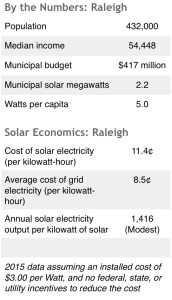 For example, a 250-kW array at the EM Johnson Water Treatment Plant was completed in 2010, and the project owner, Carolina Solar Energy, sells the solar energy to the incumbent utility, Duke Energy. The City of Raleigh earns $1,800 annually from leasing the project land. A 1.5 MW array at the Neuse River Wastewater Treatment Plant has a similar arrangement. The lease calls for annual payments to the city of about $16,000, rising by 3% per year. In both cases, the city has the option to purchase the solar array after seven years once the federal tax incentives have been fully utilized.
For example, a 250-kW array at the EM Johnson Water Treatment Plant was completed in 2010, and the project owner, Carolina Solar Energy, sells the solar energy to the incumbent utility, Duke Energy. The City of Raleigh earns $1,800 annually from leasing the project land. A 1.5 MW array at the Neuse River Wastewater Treatment Plant has a similar arrangement. The lease calls for annual payments to the city of about $16,000, rising by 3% per year. In both cases, the city has the option to purchase the solar array after seven years once the federal tax incentives have been fully utilized.
Along with smaller, city-owned solar arrays, the city is saving the city between $35,000 and $45,000 per year in combined lease rental payments and reduced electricity bills.
The projects were made possible because of state solar tax credits (35% off) and a premium-price contract from the former utility, Progress Energy, which has since become a subsidiary of Duke Energy.
Unfortunately, as state and utility incentives have shrunk, so has the city’s solar expansion. The city offers several reasons for its retrenchment:
Operational staff is wary about dealing with third parties, and they fear attorney and staff time expenses.
Duke Energy is slower in closing power purchase agreements than the former utility, Progress Energy, and its policies have been less favorable toward solar development.
City-owned solar cannot compete favorably against 9¢ per kWh utility electricity without use of the federal 30% tax credit, and investors are no longer showing as much interest in the city as in the early days of North Carolina’s solar boom.
The situation may change in Raleigh’s favor, as the legislature considers a bill to legalize third party ownership of solar panels in the 2015 session. This would allow the city to mimic Lancaster and New Bedford in buying electricity directly from non-utility developers. However, it’s unclear if these developers could profitably beat the price of electricity from Duke Energy without time-of-use pricing or identify another strategy to increase solar revenue.
Raleigh is like many U.S. cities that face substantial policy barriers to solar at the state level, but have found innovative local solutions to overcome them. However, it may have reached the limit of its opportunity without lifting some of those barriers.
TOMORROW…
PART 4: CONCLUSIONS AND SPILLOVER EFFECTS OF THE PUBLIC ROOFTOP REVOLUTION.
This article originally posted at ilsr.org. For timely updates, follow John Farrell on Twitter or get the Democratic Energy weekly update.
Rooftop Revolution: Past Reports
In 2012, ILSR published a pair of reports that projected, by 2021,10% of electricity in the U.S. could come from solar and at a lower price—without subsidies—than utility-provided electricity. In 2014 and 2015, Environment America’s Shining Cities reports examined how cities were catalysts for solar development.
By 2022, over 38 million homes and businesses could get solar power from their own rooftop, pay less for electricity, without any subsidies for solar. These two reports, published in 2012, outline the growth potential for local solar power and the coming rooftop revolution. Click to see more of our Rooftop Revolution resources.
 |
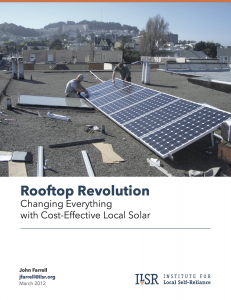 |





